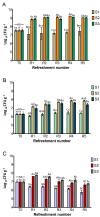Valorizing Carasau Bread Residue Through Sourdough Fermentation: From Bread Waste to Bread Taste
- PMID: 40871250
- PMCID: PMC12388447
- DOI: 10.3390/microorganisms13081745
Valorizing Carasau Bread Residue Through Sourdough Fermentation: From Bread Waste to Bread Taste
Abstract
Surplus bread accounts for a significant proportion of food waste in many countries. The focus of this study was twofold: firstly, to investigate the use of carasau bread residue as a sourdough substrate, and secondly, to reuse this sourdough into a new carasau baking process. Selected lactic acid bacteria (Lactiplantibacillus plantarum) and yeast strains (Saccharomyces cerevisiae and Wickerhamomyces anomalus) were used to inoculate three substrates: bread residue (S1), bread residue supplemented with durum wheat middlings (S2), and semolina (S3). Sourdoughs were refreshed for five days by backslopping, and microbiological and physicochemical analyses were performed. Results indicated that incorporating wheat middlings into bread residue enhanced microbial performance, as evidence by a decrease in pH from 6.0 to around 4.5 compared to using bread residue alone as a substrate. Carasau bread produced with the sourdough derived from bread residue and wheat middlings exhibited comparable physicochemical properties to commercial baker's yeast carasau bread, but had better sensory properties, scoring a mean acceptability of 7.0 versus 6.0 for baker's yeast bread. These results show that bread residue supplemented with wheat middlings can serve as a sourdough substrate, allowing its reuse in the baking process to produce high-quality carasau bread and promote the circular economy.
Keywords: Lactiplantibacillus plantarum; Saccharomyces cerevisiae; Wickerhamomyces anomalus; carasau bread; circular economy; semolina; wheat middlings.
Conflict of interest statement
The authors declare no conflicts of interest in this research article. Most of the authors are researchers employed by Porto Conte Ricerche Srl, a publicly owned research company subsidiary-controlled and financed by Sardegna Ricerche, which is an agency of the regional government of Sardinia. Author Antonio Loddo was employed by MFM Sunalle. The funders had no role in the design of the study; in the collection, analyses, or interpretation of data; in the writing of the manuscript; or in the decision to publish the results.
Figures








 ) beyond the whiskers.
) beyond the whiskers.References
-
- Mohammadi-Moghaddam T., Morshedi M., Ansari R.M., Morshedi A., Golmohamadi A. Bread Staling Measurement Techniques: A Review. J. Food Chem. Nanotechnol. 2024;10:85–93. doi: 10.17756/jfcn.2024-178. - DOI
-
- Dymchenko A., Geršl M., Gregor T. Trends in bread waste utilisation. Trends Food Sci. Technol. 2023;132:93–102. doi: 10.1016/j.tifs.2023.01.004. - DOI
Grants and funding
LinkOut - more resources
Full Text Sources

